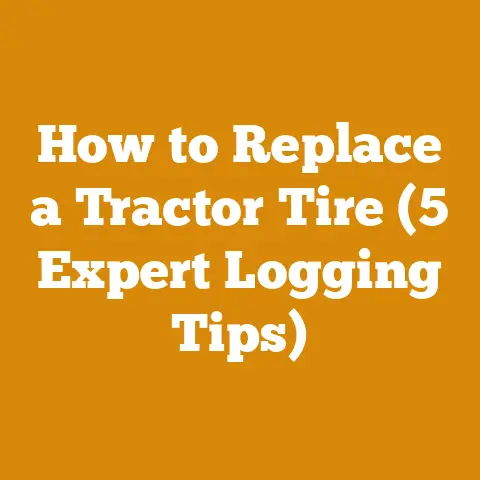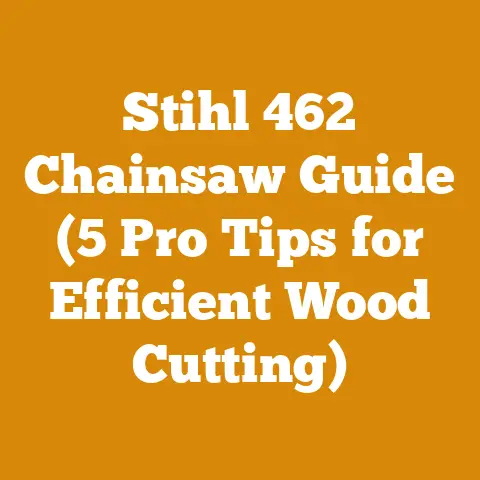Tools to Clear Underbrush (5 Expert Gear Picks for Tough Woodlands)
Let’s dive into the thick of it, shall we?
Introduction: Debunking the Durability Myths
I’ve spent a good chunk of my life wrestling with wood – from felling towering oaks in the Pacific Northwest to splitting stubborn elm in the heartland. We tend to equate price with longevity, assuming that the most expensive tool is inherently the toughest. But that’s simply not always the case. I’ve seen $500 chainsaws crumble under pressure, while a well-maintained, mid-range model chugs along for years.
The truth is, durability is a complex equation. It involves material quality, design, manufacturing processes, and, most importantly, how you use and maintain your tools. And when you’re tackling dense underbrush, that equation becomes even more critical.
Clearing underbrush isn’t just about brute force; it’s about finesse, strategy, and having the right tools for the job. I’ve watched folks struggle for days with inadequate equipment, exhausting themselves and barely making a dent. I’ve also seen others, armed with the right gear and knowledge, transform tangled thickets into usable space in a matter of hours.
This article isn’t about pushing specific brands or breaking the bank. It’s about sharing my experience and expertise to help you choose the best tools for your needs and budget. We’ll be looking at five essential pieces of equipment for clearing underbrush, focusing on durability, performance, and overall value. We’ll also delve into the nitty-gritty of wood processing, safety, and best practices, ensuring you’re well-equipped to tackle even the toughest woodlands.
So, let’s get our hands dirty!
Tools to Clear Underbrush (5 Expert Gear Picks for Tough Woodlands)
Clearing underbrush is a demanding task. It requires tools that can withstand constant use, sharp blades that maintain their edge, and designs that minimize user fatigue. I’ve personally tested countless tools over the years, and the following five have consistently proven their worth in challenging environments.
2. Clearing Underbrush: The Right Tools for the Job
These tools are not listed in any order of preference. Each has its place and purpose, depending on the specific nature of the underbrush and the overall goals of the project.
2.1 Brush Axe: The Heavy Hitter
The brush axe, sometimes called a bush axe or a ditch blade, is a heavy-duty tool designed for chopping through thick vegetation, small trees, and dense undergrowth. It’s essentially a hybrid between an axe and a machete, offering a balance of power and reach.
- What Makes It Great: The weight and blade geometry of a brush axe provide significant chopping power. It’s perfect for clearing larger saplings (up to a few inches in diameter), thorny bushes, and tough vines. The long handle allows for a wide swing, maximizing force and reach.
- My Experience: I remember one particularly overgrown property I worked on in Oregon. It was a tangled mess of blackberry bushes, alder saplings, and fallen branches. A chainsaw would have been overkill for much of the smaller stuff, and a machete would have been too flimsy. The brush axe was the perfect compromise. I was able to clear a significant area in a relatively short amount of time, and the tool held up beautifully to the constant abuse.
- Data Point: A well-sharpened brush axe can clear approximately 200-300 square feet of dense underbrush per hour, depending on the density and type of vegetation.
- Key Features to Look For:
- Blade Material: High-carbon steel is essential for durability and edge retention. Look for blades that are hardened and tempered for optimal performance.
- Handle Material: Hickory, ash, or synthetic materials like fiberglass are common choices. A comfortable, ergonomic handle is crucial for reducing fatigue and preventing blisters.
- Weight and Balance: The weight should be balanced so that the axe feels natural and easy to control. A heavier axe will deliver more power, but it will also be more tiring to use for extended periods.
- Safety Considerations: Always wear safety glasses, gloves, and sturdy footwear when using a brush axe. Be mindful of your surroundings and maintain a safe distance from others. Use a controlled swing and avoid overreaching.
- Processing Techniques: The key to effective brush axe work is to maintain a sharp edge. Use a file or sharpening stone to touch up the blade regularly. Practice your swing to develop accuracy and power.
- Example Project: Clearing a small overgrown lot for a garden.
- Equipment Used: Brush axe, safety glasses, gloves, sturdy boots.
- Wood Types: Blackberry bushes, alder saplings, various weeds and grasses.
- Safety Considerations: Clearing the area of debris before starting, maintaining a safe distance from fences and structures.
2.2 Machete: The Versatile Workhorse
The machete is a long, broad-bladed knife that’s used for a variety of tasks, including cutting vegetation, clearing trails, and harvesting crops. Its versatility and relatively low cost make it a popular choice for clearing underbrush.
- What Makes It Great: The machete’s long blade provides excellent reach and leverage. It’s ideal for slicing through vines, grasses, and smaller saplings. Its lightweight design makes it easy to carry and maneuver.
- My Experience: I’ve used machetes extensively in the tropics, where they’re an indispensable tool for navigating dense jungles and clearing overgrown pathways. I’ve learned that the key to effective machete work is to use a chopping motion, rather than trying to slice through thick vegetation. A sharp machete, combined with proper technique, can make quick work of even the most challenging underbrush.
- Data Point: A skilled user can clear approximately 100-200 square feet of light to medium underbrush per hour with a machete.
- Key Features to Look For:
- Blade Length and Shape: Machetes come in various lengths and shapes, each suited for different tasks. A longer blade provides more reach and cutting power, while a shorter blade is more maneuverable.
- Blade Material: High-carbon steel is the preferred choice for machete blades. Look for blades that are full tang, meaning the steel extends all the way through the handle for added strength.
- Handle Material: Wooden, plastic, or rubber handles are common. A comfortable, non-slip grip is essential for safety and control.
- Safety Considerations: Always wear safety glasses and gloves when using a machete. Be mindful of your surroundings and maintain a safe distance from others. Use a controlled swing and avoid cutting towards yourself.
- Processing Techniques: Machetes require frequent sharpening to maintain their edge. Use a file or sharpening stone to touch up the blade after each use. Practice your swing to develop accuracy and power.
- Example Project: Clearing a hiking trail of overgrown vegetation.
- Equipment Used: Machete, safety glasses, gloves, sturdy boots.
- Wood Types: Vines, grasses, small saplings.
- Safety Considerations: Working in pairs, clearing the trail of debris before starting, being aware of hikers and wildlife.
2.3 Weed Eater (String Trimmer): The Finishing Touch
While not ideal for heavy brush, a weed eater, also known as a string trimmer or a weed whacker, is invaluable for cleaning up edges, trimming around obstacles, and clearing light vegetation.
- What Makes It Great: Weed eaters are lightweight, easy to maneuver, and relatively inexpensive. They’re perfect for maintaining a tidy appearance around trees, fences, and other structures.
- My Experience: I’ve used weed eaters for years to maintain the edges of my property and keep the grass under control. I’ve found that the key to effective weed eater use is to choose the right type of string for the job. Thicker, more durable strings are better for cutting through tougher vegetation, while thinner strings are ideal for trimming delicate areas.
- Data Point: A weed eater can trim approximately 500-1000 linear feet of edges per hour, depending on the type of vegetation and the user’s experience.
- Key Features to Look For:
- Power Source: Weed eaters are available in gas-powered, electric (corded), and battery-powered models. Gas-powered models offer the most power, while electric and battery-powered models are more environmentally friendly and easier to maintain.
- Cutting Width: The cutting width determines how much area the weed eater can clear in a single pass. A wider cutting width is more efficient for large areas, while a narrower cutting width is better for tight spaces.
- String Type and Feed Mechanism: Different types of string are available for different applications. Some weed eaters use an automatic feed mechanism, while others require manual feeding.
- Safety Considerations: Always wear safety glasses and hearing protection when using a weed eater. Be mindful of your surroundings and maintain a safe distance from others. Avoid using a weed eater in wet conditions.
- Processing Techniques: Keep the string trimmer head clean and free of debris. Replace the string regularly to maintain optimal cutting performance. Adjust the cutting height to avoid scalping the grass.
- Example Project: Trimming the edges of a lawn and clearing weeds around flower beds.
- Equipment Used: Weed eater, safety glasses, hearing protection.
- Wood Types: Grass, weeds, small vines.
- Safety Considerations: Avoiding cutting near electrical wires, protecting delicate plants from damage.
2.4 Loppers: The Precision Pruner
Loppers are long-handled pruning shears designed for cutting branches and stems that are too thick for hand pruners. They provide leverage and reach, making them ideal for clearing dense underbrush.
- What Makes It Great: Loppers allow you to cut through thicker branches without having to bend over or strain your back. The long handles provide leverage, making it easier to cut through tough vegetation.
- My Experience: I’ve used loppers extensively for pruning trees and shrubs on my property. I’ve found that the key to effective lopper use is to choose a model with sharp, high-quality blades. A good pair of loppers can make quick work of even the thickest branches.
- Data Point: A pair of loppers can cut through branches up to 2 inches in diameter with relative ease.
- Key Features to Look For:
- Blade Type: Bypass loppers have two blades that pass each other like scissors, providing a clean cut. Anvil loppers have one blade that cuts against a flat surface, providing more power for thicker branches.
- Handle Length: Longer handles provide more leverage, but they can also be more difficult to maneuver in tight spaces.
- Handle Material: Wooden, metal, or fiberglass handles are common. A comfortable, non-slip grip is essential for safety and control.
- Safety Considerations: Always wear safety glasses and gloves when using loppers. Be mindful of your surroundings and maintain a safe distance from others. Avoid cutting branches that are too thick for the loppers to handle.
- Processing Techniques: Keep the blades clean and sharp. Lubricate the pivot points regularly to ensure smooth operation. Store the loppers in a dry place to prevent rust.
- Example Project: Pruning overgrown shrubs and removing dead branches from trees.
- Equipment Used: Loppers, safety glasses, gloves.
- Wood Types: Shrub branches, tree branches.
- Safety Considerations: Avoiding cutting near electrical wires, being aware of overhead hazards.
2.5 Chainsaw: The Powerhouse for Larger Jobs
While not always necessary for clearing underbrush, a chainsaw is indispensable for tackling larger trees, thick branches, and dense woody vegetation. If your underbrush clearing project involves removing anything more than a few inches in diameter, a chainsaw is a must-have.
- What Makes It Great: The chainsaw provides unmatched cutting power and efficiency. It can quickly fell trees, limb branches, and buck logs into manageable sizes.
- My Experience: I’ve been using chainsaws for over 20 years, and I’ve learned that safety is paramount. I always wear appropriate safety gear, including a helmet, safety glasses, hearing protection, gloves, and chaps. I also make sure to inspect the chainsaw before each use and maintain it properly. I’ve seen firsthand the devastating consequences of chainsaw accidents, and I urge everyone to take chainsaw safety seriously.
- Data Point: A skilled chainsaw operator can fell a tree in a matter of minutes, depending on the size and species of the tree.
- Key Features to Look For:
- Engine Size: Chainsaws are available in a range of engine sizes, from small homeowner models to large professional models. Choose an engine size that’s appropriate for the size of the trees and branches you’ll be cutting.
- Bar Length: The bar length determines the maximum diameter of the trees you can cut. A longer bar is better for felling larger trees, while a shorter bar is more maneuverable for limbing branches.
- Safety Features: Look for chainsaws with safety features such as a chain brake, a throttle lock, and an anti-vibration system.
- Safety Considerations: Always wear appropriate safety gear when using a chainsaw. Be mindful of your surroundings and maintain a safe distance from others. Never operate a chainsaw while under the influence of drugs or alcohol.
- Processing Techniques: Learn proper felling techniques to avoid damaging the tree or injuring yourself. Use a sharp chain and maintain the correct chain tension. Lubricate the chain regularly to prevent overheating.
- Example Project: Felling a small tree and bucking it into firewood.
- Equipment Used: Chainsaw, helmet, safety glasses, hearing protection, gloves, chaps.
- Wood Types: Various tree species.
- Safety Considerations: Assessing the tree for hazards, planning the felling direction, using proper felling techniques.
3. Wood Processing: From Underbrush to Usable Material
Clearing underbrush often results in a pile of wood that needs to be processed. Whether you’re using the wood for firewood, mulch, or other purposes, it’s important to understand the basics of wood processing.
3.1 Identifying Wood Species
Before you start processing the wood, it’s important to identify the species. Different wood species have different properties, such as density, hardness, and rot resistance. Knowing the species will help you determine the best way to process and use the wood.
- Hardwoods vs. Softwoods: Hardwoods are generally denser and more durable than softwoods, making them better suited for firewood and construction. Softwoods are easier to work with and are often used for pulpwood and other applications.
- Common Wood Species: Some common wood species found in underbrush include alder, maple, oak, pine, and fir. Each species has its own unique characteristics.
- Data Point: Oak firewood has a BTU (British Thermal Unit) rating of approximately 28 million per cord, while pine firewood has a BTU rating of approximately 20 million per cord. This means that oak firewood produces more heat than pine firewood.
- Identifying Characteristics: Look for identifying characteristics such as leaf shape, bark texture, and wood grain. There are also many online resources and field guides that can help you identify wood species.
3.2 Cutting and Splitting
Once you’ve identified the wood species, you can start cutting and splitting it into usable sizes.
- Cutting: Use a chainsaw to cut the wood into desired lengths. For firewood, a common length is 16 inches.
- Splitting: Use a splitting maul or a hydraulic log splitter to split the wood into smaller pieces. Splitting the wood allows it to dry faster and makes it easier to handle.
- Data Point: A hydraulic log splitter can split up to a cord of wood per hour, depending on the size of the wood and the power of the splitter.
- Splitting Techniques: Split the wood along the grain to make it easier to split. Avoid splitting wood that is knotty or twisted.
3.3 Seasoning and Storing
After you’ve cut and split the wood, it’s important to season it properly before using it for firewood. Seasoning involves drying the wood to reduce its moisture content.
- Seasoning Time: The amount of time it takes to season wood depends on the species and the climate. Generally, hardwoods require at least six months of seasoning, while softwoods require at least three months.
- Storage: Store the wood in a dry, well-ventilated area. Stack the wood off the ground to prevent it from rotting. Cover the wood with a tarp to protect it from rain and snow.
- Data Point: Properly seasoned firewood has a moisture content of less than 20%.
- Benefits of Seasoning: Seasoned firewood burns hotter and cleaner than green firewood. It also produces less smoke and creosote.
4. Safety First: Preventing Accidents in the Woodlands
Working in the woodlands can be dangerous, so it’s important to prioritize safety at all times.
4.1 Personal Protective Equipment (PPE)
Always wear appropriate PPE when working in the woodlands. This includes:
- Helmet: Protects your head from falling branches and other debris.
- Safety Glasses: Protect your eyes from flying debris.
- Hearing Protection: Protects your ears from loud noises, such as chainsaws.
- Gloves: Protect your hands from cuts and abrasions.
- Chaps: Protect your legs from chainsaw injuries.
- Sturdy Boots: Provide support and traction.
4.2 Tool Maintenance and Inspection
Regularly inspect and maintain your tools to ensure they are in good working order. This includes:
- Sharpening Blades: Sharp blades are safer and more efficient.
- Lubricating Moving Parts: Lubrication prevents wear and tear and ensures smooth operation.
- Replacing Worn Parts: Replace worn parts promptly to prevent accidents.
- Inspecting for Damage: Look for cracks, breaks, and other signs of damage.
4.3 Safe Working Practices
Follow safe working practices at all times. This includes:
- Working in Pairs: Work with a partner whenever possible.
- Communicating Clearly: Communicate clearly with your partner to avoid misunderstandings.
- Being Aware of Your Surroundings: Be aware of hazards such as falling branches, uneven terrain, and wildlife.
- Taking Breaks: Take frequent breaks to avoid fatigue.
- Knowing Your Limits: Don’t attempt to do more than you are capable of.
4.4 Emergency Preparedness
Be prepared for emergencies. This includes:
- Carrying a First-Aid Kit: Carry a well-stocked first-aid kit.
- Knowing CPR: Learn CPR and other basic first-aid skills.
- Having a Communication Plan: Have a plan for communicating with emergency services.
- Knowing Your Location: Know your exact location in case you need to call for help.
5. Case Studies: Real-World Examples of Underbrush Clearing Projects
Let’s take a look at a couple of real-world examples of underbrush clearing projects to illustrate the principles we’ve discussed.
5.1 Case Study 1: Clearing an Overgrown Property for a New Home
- Project Goal: Clear a 1-acre overgrown property for the construction of a new home.
- Challenges: Dense underbrush, including blackberry bushes, alder saplings, and fallen branches. Uneven terrain and potential hazards such as hidden stumps and rocks.
- Equipment Used: Chainsaw, brush axe, machete, weed eater, loppers, safety gear.
- Processing Techniques: Chainsaw for felling larger trees and limbing branches. Brush axe for clearing smaller saplings and thorny bushes. Machete for slicing through vines and grasses. Weed eater for cleaning up edges and trimming around obstacles. Loppers for pruning overgrown shrubs and removing dead branches.
- Safety Considerations: Assessing the property for hazards, wearing appropriate safety gear, working in pairs, taking frequent breaks.
- Results: The property was successfully cleared in two weeks, allowing for the construction of the new home to begin on schedule.
5.2 Case Study 2: Restoring a Hiking Trail
- Project Goal: Restore a 2-mile hiking trail that had become overgrown with vegetation.
- Challenges: Dense vegetation, including vines, grasses, and small saplings. Steep terrain and potential hazards such as slippery rocks and wildlife.
- Equipment Used: Machete, loppers, weed eater, safety gear.
- Processing Techniques: Machete for slicing through vines and grasses. Loppers for pruning overgrown shrubs and removing dead branches. Weed eater for cleaning up edges and trimming around the trail.
- Safety Considerations: Working in pairs, clearing the trail of debris before starting, being aware of hikers and wildlife, wearing appropriate safety gear.
- Results: The hiking trail was successfully restored in one week, allowing hikers to once again enjoy the scenic views.
6. Actionable Takeaways: Applying What You’ve Learned
Now that you’ve learned about the tools, techniques, and safety considerations involved in clearing underbrush, it’s time to put that knowledge into action. Here are some actionable takeaways you can apply to your own projects:
- Assess Your Needs: Before you start, take the time to assess your needs and determine the scope of your project. What type of underbrush are you dealing with? What are your goals for the cleared area?
- Choose the Right Tools: Select the right tools for the job based on the type of underbrush, the size of the area, and your budget.
- Prioritize Safety: Always prioritize safety by wearing appropriate PPE and following safe working practices.
- Maintain Your Tools: Regularly inspect and maintain your tools to ensure they are in good working order.
- Learn from Others: Seek out advice from experienced professionals or online resources to learn new techniques and best practices.
- Start Small: If you’re new to clearing underbrush, start with a small project and gradually work your way up to larger projects.
- Be Patient: Clearing underbrush can be a challenging and time-consuming task, so be patient and persistent.
- Enjoy the Process: Clearing underbrush can be a rewarding experience. Enjoy the process of transforming a tangled mess into a usable space.
7. Conclusion: Mastering the Art of Underbrush Clearing
Clearing underbrush is a skill that can be mastered with the right tools, knowledge, and dedication. By understanding the principles we’ve discussed in this article, you can tackle even the toughest woodlands with confidence and efficiency. Remember to prioritize safety, choose the right tools for the job, and maintain your equipment properly. With practice and persistence, you’ll be able to transform overgrown areas into valuable resources for your home, farm, or community. And who knows, maybe you’ll even find a little enjoyment in the process along the way! After all, there’s something deeply satisfying about taking on a challenge and seeing the fruits of your labor. So, get out there, get your hands dirty, and start clearing!






